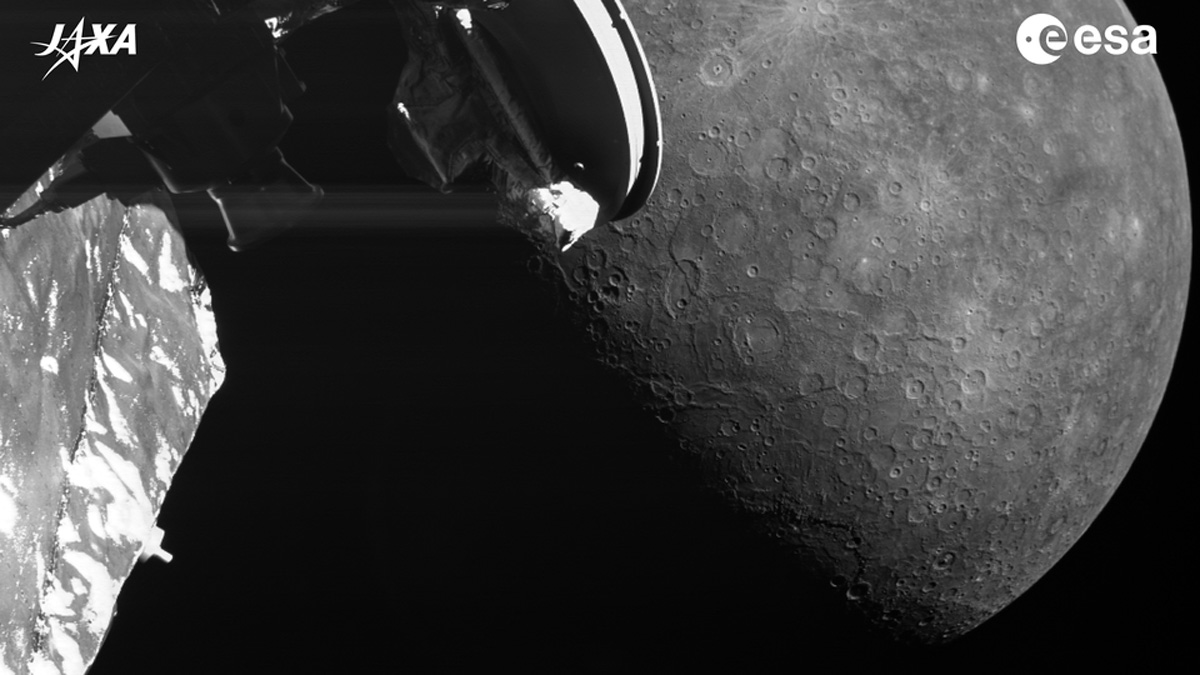Watch Mercury roll by in a stunning sequence from BepiColombo probe (video)
BepiColombo took the images during a gravity-assist flyby designed to slow the probe down.
The European-Japanese BepiColombo spacecraft took this stunning sequence of images of its target planet Mercury during a gravity assist flyby designed to alter its speed.
The flyby, which took place on Monday (June 19), saw BepiColombo whizz merely 150 miles (236 kilometers) above the surface of the scorching innermost planet of the solar system. During the maneuver, spacecraft operators used three monitoring cameras mounted on the spacecraft's body to capture views of the planet rolling by below.
The video, released by the European Space Agency (ESA) on Thursday (June 22), consists of 217 photographs taken during BepiColombo's retreat from the planet. The sequence starts with the probe 1,111 miles (1,789 km) above Mercury and ends at a distance of 206,142 miles (331,755 km). Unfortunately, the cameras couldn't capture BepiColombo's closest approach, which occurred while the spacecraft was on the planet's night side.
Related: 10 strange Mercury facts
During the flyby, the probe got a glimpse of a range of geological features including a 135-mile-wide (218 km) impact crater, which had just been named after Jamaican/British artist Edna Manley, and a 370-mile-long (600 km) tectonic cliff the Beagle Rupes, previously photographed by NASA's Messenger mission about a decade ago.
BepiColombo scientists used the images and previous data collected by Messenger to recreate a section of the planet's surface in 3D. This 3D depiction is attached at the end of the video.
Since its launch in 2018, BepiColombo has been orbiting the sun, taking advantage of the gravities of planets Earth, Venus and its target Mercury to reduce its speed so that it can enter the orbit of the latter in late 2025. These maneuvers are necessary because spacecraft in the inner solar system are constantly pulled toward the sun by the star's enormous gravitational force. For BepiColombo, that means a lot of braking to slow down enough so that the tiny Mercury, which is only a little larger than Earth's moon, can capture it.
Breaking space news, the latest updates on rocket launches, skywatching events and more!
The probe has already conducted two Mercury flybys in 2021 and 2022 and will perform three more before it finally sheds enough energy to enter its orbit.
The BepiColombo spacecraft consists of two orbiters that travel through space stacked on top of each other. This configuration hides some of the probe's instruments, including its primary high-resolution cameras. The black and white cameras that took the images during the flyby offer a modest resolution of 1024 x 1024 pixels. BepiColombo operators originally used those cameras to monitor the spacecraft's solar array deployment after its launch, but have continued taking advantage of them to allow BepiColombo to send home postcards from its journey. The spacecraft previously shared with the world its views of Earth and Venus.

Tereza is a London-based science and technology journalist, aspiring fiction writer and amateur gymnast. Originally from Prague, the Czech Republic, she spent the first seven years of her career working as a reporter, script-writer and presenter for various TV programmes of the Czech Public Service Television. She later took a career break to pursue further education and added a Master's in Science from the International Space University, France, to her Bachelor's in Journalism and Master's in Cultural Anthropology from Prague's Charles University. She worked as a reporter at the Engineering and Technology magazine, freelanced for a range of publications including Live Science, Space.com, Professional Engineering, Via Satellite and Space News and served as a maternity cover science editor at the European Space Agency.

